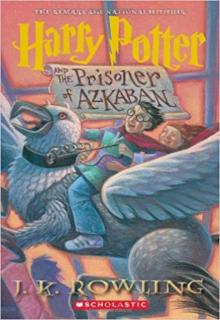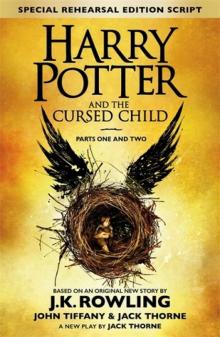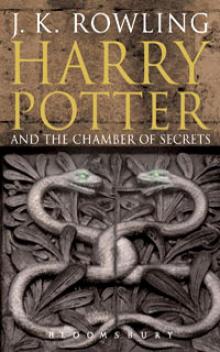- Home
- J. K. Rowling
The Hogwarts Collection Page 2
The Hogwarts Collection Read online
Page 2
Relationship with Harry Potter
Minerva McGonagall was not immune to a secret amusement at the antics of rule-breakers. Nevertheless, she frequently questioned Dumbledore’s policy of allowing Harry to run extreme risks, and bend many school rules, during his adolescence, often showing herself to be more protective of Harry than the then Headmaster. Harry had a claim on Minerva’s affections, not only because he was the son of two of her all-time favourite students, but because he, like herself, had suffered serious bereavements. Although she neither spoiled nor favoured Harry when he was her student, she revealed the depth of her trust in him during the Battle of Hogwarts, at which time she supported him unequivocally even though she had never been fully in his or Dumbledore’s confidence.
Following a private conversation with Harry, Minerva McGonagall later took the controversial decision to add a portrait of Severus Snape to the gallery of old headmasters and headmistresses in her tower office.
J.K. Rowling’s thoughts
Minerva was the Roman goddess of warriors and wisdom. William McGonagall is celebrated as the worst poet in British history. There was something irresistible to me about his name, and the idea that such a brilliant woman might be a distant relative of the buffoonish McGonagall.
A small sample of his work will give a flavour of its unintentional comedic value. The following was written as part of a poem commemorating a Victorian railway disaster:
Beautiful Railway Bridge of the Sil’vry Tay!
Alas! I am very sorry to say
That ninety lives have been taken away
On the last Sabbath day of 1879,
Which will be remember’d for a very long time.
The first time we meet Professor McGonagall, she’s at the corner of Privet Drive in the form of a tabby cat, reading a map. It’s only when Dumbledore arrives that she Transfigures back into her human form. This rare ability to switch between feline and human form makes McGonagall an Animagus. Exactly how arduous and particular is this type of magic? Let’s find out.
ANIMAGI
BY J.K. ROWLING
An Animagus is a witch or wizard who can transform at will into an animal. While in their animal form, they retain most of their ability to think as a human, their own sense of identity and their memories. They will also retain normal human life expectancy, even if they take their animal form for long periods of time. However, feelings and emotions are simplified and they will have many animal desires, feeding off whatever their animal body craves, rather than demanding human food.
It is immensely difficult to change oneself into an Animagus and the process, which is complex and time-consuming, can go dramatically wrong. As a result, it is believed that fewer than one in a thousand witches or wizards are Animagi.
An Animagus has a great potential advantage in the spheres of espionage and crime. For this reason, an Animagus Registry exists on which all Animagi are expected to log their personal details and the precise appearance of their transformed self. It is usually the case that distinctive markings or disabilities belonging to the human body will transfer to the animal self. Failure to enter oneself onto the Registry may result in a stretch in Azkaban.
When the process of becoming an Animagus goes wrong, it often goes seriously wrong. Impatience with the long and complicated process is generally at the root of such disasters, which usually take the form of horrible half-human, half-animal mutations. There is no known cure for such mistakes and those who make them are often forced to live out their days in their pitiable condition, being unable to become fully animal or fully human.
Talent in both Transfiguration and Potions is necessary to become an Animagus. No responsibility can be taken for any physical or mental problems resulting from following these instructions.
1. For the space of one entire month (from full moon to full moon), a single leaf from a Mandrake must be carried constantly in the mouth. The leaf must not be swallowed or taken out of the mouth at any point. If the leaf is removed from the mouth, the process must be started again.
2. Remove the leaf at the full moon and place it, steeped in your saliva, in a small crystal phial that receives the pure rays of the moon (if the night is cloudy, you will have to find a new Mandrake leaf and begin the whole process again). To the moon-struck crystal phial, add one of your own hairs, a silver teaspoon of dew collected from a place that neither sunlight nor human feet have touched for a full seven days, and the chrysalis of a Death’s-head Hawk Moth. Put this mixture in a quiet, dark place and do not look at it or otherwise disturb it until the next electrical storm.
3. While waiting for the storm, the following procedure should be followed at sunrise and sundown. The tip of the wand should be placed over the heart and the following incantation spoken: ‘Amato Animo Animato Animagus.’
4. The wait for a storm may take weeks, months or even years. During this time, the crystal phial should remain completely undisturbed and untouched by sunlight. Contamination by sunlight gives rise to the worst mutations. Resist the temptation to look at your potion until lightning occurs. If you continue to repeat your incantation at sunrise and sunset there will come a time when, with the touch of the wand-tip to the chest, a second heartbeat may be sensed, sometimes more powerful than the first, sometimes less so. Nothing should be changed. The incantation should be uttered without fail at the correct times, never omitting a single occasion.
5. Immediately upon the appearance of lightning in the sky, proceed directly to the place where your crystal phial is hidden. If you have followed all the preceding steps correctly, you will discover a mouthful of blood-red potion inside it.
6. It is essential to move, at once, to a large, secure place where your transformation cannot cause alarm or place you in physical danger. Place your wand-tip against your heart, speak the incantation ‘Amato Animo Animato Animagus,’ and then drink the potion.
7. If all has gone correctly, you will feel a fiery pain and an intense double heartbeat. Into your mind will come the shape of the creature into which you are shortly to transform. You must show no fear. It is too late, now, to escape the change you have willed.
8. The first transformation is usually uncomfortable and frightening. Clothing and items such as glasses or jewellery meld to the skin and become one with fur, scales or spikes. Do not resist and do not panic or the animal mind may gain the ascendancy and you could do something foolish, such as try to escape through a window or charge a wall.
9. When your transformation is complete you should find yourself physically comfortable. You are strongly advised to pick up your wand at once, and hide it in a place of safekeeping, where you will be able to find it when you regain a human form.
10. To return to a human form, visualise your human self as clearly as you can. This should be sufficient, but do not panic if the transformation does not occur immediately. With practice, you will be able to slip in and out of your animal form at will, simply by visualising the creature. Advanced Animagi can transform without wands.
Generally wizards prefer to have their clothes Transfigure with them, to escape the embarrassment of reappearing naked. However, it is possible to leave clothes behind if one wishes to give the impression of having gone for a bath or something similar. The longer a witch or wizard has been an Animagus, the better they will become at choosing the precise form of their transformations.
The animal into which one turns, if an Animagus, seems always to be that which becomes the Patronus. There is no known instance of the Animagus form changing to match the Patronus if the latter changes, but the Animagus who can also produce a Patronus is highly unusual and no study has ever been done on sufficient numbers to draw firm conclusions.
Being an Animagus is a privilege – one that requires immense skill and hard work. Being a werewolf, on the other hand, is something that happens to witches and wizards against their will. The life of a werewolf can be torturous and often lonely, as we learned from Remus Lupin.
REMUS LUPIN
BY J.K. ROWLING
BIRTHDAY:
10th March
WAND:
Cypress and unicorn hair, ten and a quarter inches, pliable
HOGWARTS HOUSE:
Gryffindor
SPECIAL ABILITIES:
Exceptionally gifted in Defence Against the Dark Arts, werewolf
PATRONUS:
Wolf
PARENTAGE:
Wizard father, Muggle mother
FAMILY:
Wife Nymphadora Tonks, son Edward Remus (Teddy) Lupin
Parents
Remus Lupin was the only child of the wizard Lyall Lupin and his Muggle wife Hope Howell.
Lyall Lupin was a very clever, rather shy young man who, by the time he was thirty, had become a world-renowned authority on Non-Human Spiritous Apparitions. These include poltergeists, Boggarts and other strange creatures that, while sometimes ghostlike in appearance and behaviour, have never been truly alive and remain something of a mystery even to the wizarding world.
On an investigative trip into a dense Welsh forest in which a particularly vicious Boggart was supposed to be lurking, Lyall ran across his future wife. Hope Howell, a beautiful Muggle girl who worked in an insurance office in Cardiff, had taken an ill-advised walk through what she believed to be innocent woodland. Boggarts and poltergeists may be sensed by Muggles, and Hope, a particularly imaginative and sensitive person, had become convinced that something was watching her from between the dark trees. Eventually, her imagination became so overactive that the Boggart assumed a form: that of a large, evil-looking man, bearing down on her with a snarl and outstretched hands in the gloom. Hearing her scream, young Lyall came sprinting through the trees, causing the apparition to shrink into a field mushroom with one wave of his wand. The terrified Hope thought, in her confusion, that he had driven her would-be attacker away, and his first words to her – ‘it’s all right, it was only a Boggart’ – made no impression on her. Noticing how very beautiful she was, Lyall made the wise decision not to talk about Boggarts any more, but instead agreed that the man had been very big and scary, and that the only sensible thing to do was for him to accompany Hope home to protect her.
The young couple fell in love, and not even Lyall’s shamefaced admission, some months later, that Hope had never really been in danger, dented her enthusiasm for him. To Lyall’s delight, Hope accepted his proposal of marriage and threw herself enthusiastically into preparations for the wedding, complete with a Boggart-topped cake.
Lyall and Hope’s first and only child, Remus John, was born after a year of marriage. A happy, healthy little boy, he showed early signs of magic and both parents imagined that he would follow in his father’s footsteps, attending Hogwarts School of Witchcraft and Wizardry in due course.
Bitten
By the time that Remus was four years old, the amount of Dark magical activity across the country was increasing steadily. While few yet knew what lay behind the mounting attacks and sightings, Lord Voldemort’s first ascent to power was in progress and Death Eaters were recruiting all kinds of Dark creatures to join them in their quest to overthrow the Ministry of Magic. The Ministry called in the services of authorities on Dark creatures – even those as minor as Boggarts and poltergeists – to help it understand and contain the threat. Lyall Lupin was among those asked to join the Department for the Regulation and Control of Magical Creatures, which he did gladly. It was here that Lyall came face-to-face with a werewolf called Fenrir Greyback, who had been brought in for questioning about the death of two Muggle children.
The Werewolf Registry was badly maintained. Werewolves were so shunned by wizarding society that they generally avoided contact with other people; they lived in self-described ‘packs’ and did all they could to avoid being registered. Greyback, whom the Ministry did not know to be a werewolf, claimed to be nothing more than a Muggle tramp who was utterly amazed at finding himself in a room full of wizards, and horrified by the talk about the poor, dead children.
Greyback’s filthy clothing and lack of wand were sufficient to persuade two overworked and ignorant members of the questioning committee that he was telling the truth, but Lyall Lupin was not so easily fooled. He recognised certain telltale signs in Greyback’s appearance and behaviour and told the committee that Greyback ought to be kept in detention until the next full moon, a mere twenty-four hours later.
Greyback sat in silence while Lyall was laughed at by his fellow committee members (‘Lyall, you just stick to Welsh Boggarts, that’s what you’re good at’). Lyall, generally a mild-mannered man, grew angry. He described werewolves as ‘soulless, evil, deserving nothing but death’. The committee ordered Lyall out of the room, the head of the committee apologised to the Muggle tramp and Greyback was released.
The wizard who escorted Greyback out of the inquiry was intending to place a Memory Charm upon him, so that he would forget having been inside the Ministry. Before he had a chance to do so, he was overpowered by Greyback and two accomplices who had been lurking at the entrance, and the three werewolves fled.
Greyback lost no time in sharing with his friends how Lyall Lupin had just described them. Their revenge on the wizard who thought that werewolves deserved nothing but death would be swift and terrible.
Shortly before Remus Lupin’s fifth birthday, as he slept peacefully in his bed, Fenrir Greyback forced open the boy’s window and attacked him. Lyall reached the bedroom in time to save his son’s life, driving Greyback out of the house with a number of powerful curses. However, henceforth, Remus would be a fully fledged werewolf.
Lyall Lupin never forgave himself for the words he had spoken in front of Greyback at the inquiry: ‘soulless, evil, deserving nothing but death’. He had parroted what was the common view of werewolves in his community, but his son was what he had always been – loveable and clever – except for that terrible period at the full moon when he suffered an excruciating transformation and became a danger to everyone around him. For many years, Lyall kept the truth about the attack, including the identity of the attacker, from his son, fearing Remus’s recriminations.
Childhood
Lyall did all he could to find a cure, but neither potions nor spells could help his son. From this time onwards, the family’s lives were dominated by the need to hide Remus’s condition. They uprooted themselves from village to town, leaving the instant that rumours of the boy’s odd behaviour started. Fellow witches and wizards noticed how peaky Remus became as new moon approached, not to mention his monthly disappearances. Remus was not allowed to play with other children, in case he let slip the truth of his condition. In consequence, and in spite of his loving parents, he was a very lonely boy.
While Remus was small, his containment during his transformation was not difficult; a locked room and plenty of silencing spells usually sufficed. However, as he grew, so did his wolfish self, and by the time he was ten years old, he was capable of pounding down doors and smashing windows. Ever more powerful spells were needed to contain him and both Hope and Lyall grew thin with worry and fear. They adored their son, but they knew that their community – already beset with fears at the mounting Dark activity around them – would not be lenient on an uncontrolled werewolf. The hopes that they had once had for their son seemed in ruins, and Lyall educated Remus at home, certain that he would never be able to set foot in school.
Shortly before Remus’s eleventh birthday, no less a person than Albus Dumbledore, Headmaster of Hogwarts, arrived uninvited on the Lupins’ doorstep. Flustered and frightened, Lyall and Hope tried to block his entrance, but somehow, five minutes later, Dumbledore was sitting at the fireside, eating crumpets and playing Gobstones with Remus.
Dumbledore explained to the Lupins that he knew what had happene
d to their son. Greyback had boasted of what he had done and Dumbledore had spies among Dark creatures. However, Dumbledore told the Lupins that he saw no reason why Remus should not come to school, and described the arrangements that he had made to give the boy a safe and secure place for his transformations. Due to the widespread prejudice around werewolves, Dumbledore agreed that for Remus’s own sake his condition should not be broadcast. Once a month, he would leave for a secure and comfortable house in the village of Hogsmeade, guarded by many spells and reached only by an underground passage from the Hogwarts grounds, where he could transform in peace.
Remus’s excitement was beyond anything he had known before. It was the dream of his life to meet other children and have, for the first time, friends and playmates.
School
Sorted into Gryffindor house, Remus Lupin was swiftly befriended by two cheerful, confident and rebellious boys, James Potter and Sirius Black. They were attracted by Remus’s quiet sense of humour and a kindness that they valued, even if they did not always possess it themselves. Remus, always the underdog’s friend, was kind to short and rather slow Peter Pettigrew, a fellow Gryffindor, whom James and Sirius might not have thought worthy of their attention without Remus’s persuasion. Soon, these four became inseparable.
Remus functioned as the conscience of this group, but it was an occasionally faulty conscience. He did not approve of their relentless bullying of Severus Snape, but he loved James and Sirius so much, and was so grateful for their acceptance, that he did not always stand up to them as much as he knew he should.

 Harry Potter and the Philosophers Stone
Harry Potter and the Philosophers Stone Harry Potter and the Chamber of Secrets
Harry Potter and the Chamber of Secrets Harry Potter and the Goblet of Fire
Harry Potter and the Goblet of Fire Harry Potter and the Deathly Hallows
Harry Potter and the Deathly Hallows Harry Potter and the Order of the Phoenix
Harry Potter and the Order of the Phoenix Harry Potter and the Half-Blood Prince
Harry Potter and the Half-Blood Prince Harry Potter and the Prisoner of Azkaban
Harry Potter and the Prisoner of Azkaban Fantastic Beasts and Where to Find Them
Fantastic Beasts and Where to Find Them Short Stories from Hogwarts of Heroism, Hardship and Dangerous Hobbies
Short Stories from Hogwarts of Heroism, Hardship and Dangerous Hobbies Hogwarts: An Incomplete and Unreliable Guide
Hogwarts: An Incomplete and Unreliable Guide The Tales of Beedle the Bard
The Tales of Beedle the Bard The Casual Vacancy
The Casual Vacancy Harry Potter and the Cursed Child
Harry Potter and the Cursed Child Short Stories from Hogwarts of Power, Politics and Pesky Poltergeists
Short Stories from Hogwarts of Power, Politics and Pesky Poltergeists Quidditch Through the Ages
Quidditch Through the Ages The Ickabog
The Ickabog![Fantastic Beasts, The Crimes of Grindelwald [UK] Read online](http://i1.bookreadfree.com/i/03/19/fantastic_beasts_the_crimes_of_grindelwald_uk_preview.jpg) Fantastic Beasts, The Crimes of Grindelwald [UK]
Fantastic Beasts, The Crimes of Grindelwald [UK] Harry Potter and the Cursed Child: Parts One and Two
Harry Potter and the Cursed Child: Parts One and Two The Prisoner of Azkaban
The Prisoner of Azkaban Fantastic Beasts: The Crimes of Grindelwald
Fantastic Beasts: The Crimes of Grindelwald The Hogwarts Library Collection
The Hogwarts Library Collection Short Stories from Hogwarts of Heroism, Hardship and Dangerous Hobbies (Kindle Single) (Pottermore Presents)
Short Stories from Hogwarts of Heroism, Hardship and Dangerous Hobbies (Kindle Single) (Pottermore Presents) Harry Potter and the Deathly Hallows hp-7
Harry Potter and the Deathly Hallows hp-7 Hogwarts: An Incomplete and Unreliable Guide (Kindle Single) (Pottermore Presents)
Hogwarts: An Incomplete and Unreliable Guide (Kindle Single) (Pottermore Presents) Harry Potter and the Goblet of Fire hp-4
Harry Potter and the Goblet of Fire hp-4 The Christmas Pig
The Christmas Pig Harry Potter and the Sorcerer's Stone
Harry Potter and the Sorcerer's Stone The Order of the Phoenix
The Order of the Phoenix Harry Potter and the Prisoner of Azkaban hp-3
Harry Potter and the Prisoner of Azkaban hp-3 Harry Potter and the Chamber of Secrets hp-2
Harry Potter and the Chamber of Secrets hp-2 HP 3 - Harry Potter and the Prisoner of Azkaban
HP 3 - Harry Potter and the Prisoner of Azkaban The Half-Blood Prince
The Half-Blood Prince The Hogwarts Collection
The Hogwarts Collection Tales of Beedle the Bard
Tales of Beedle the Bard The Goblet of Fire
The Goblet of Fire Harry Potter and the Half-Blood Prince hp-6
Harry Potter and the Half-Blood Prince hp-6 Short Stories from Hogwarts of Power, Politics and Pesky Poltergeists (Kindle Single) (Pottermore Presents)
Short Stories from Hogwarts of Power, Politics and Pesky Poltergeists (Kindle Single) (Pottermore Presents) Harry Potter and the Sorcerer's Stone hp-1
Harry Potter and the Sorcerer's Stone hp-1